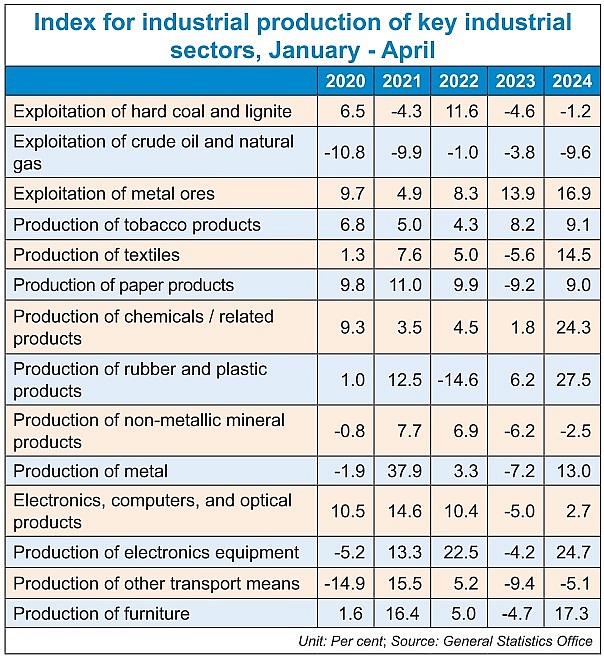Precarious figures in business operations
According to the General Statistics Office (GSO), the first four months of this year saw the index of industrial production (IIP) estimated to increase 6 per cent as compared to that in the same last year, when the IIP dropped 2.5 per cent. However, a 6 per cent increase is not big, and difficulties are still lingering.
The manufacturing and processing industry, which creates more than 80 per cent of industrial growth, climbed 6.3 per cent as compared to the corresponding period last year when the rate went down by 2.9 per cent on-year.
The electricity production and distribution industry climbed 12.3 per cent on-year – versus a 0.12 per cent on-year reduction in the first four months of last year.
Also in the first four months of this year, the waste and wastewater treatment and water supply industry ascended 5.3 per cent on-year – lower than the 6.2 per cent on-year increase in the same period last year. In addition, the mining industry fell 4.6 per cent on-year versus a decrease of 3.7 per cent on-year in the corresponding period last year.
“A closer look at the figures reveal the fact that the economy is facing numerous difficulties. Such on-year increases in the four-month figures are based on very low, or even below-zero rises recorded in the same period last year,” said Nguyen Hoang Huong, deputy general director of a textile company in Hanoi.
 |
“For example, in the case of our company, it is estimated that our revenue growth in the first four months of 2024 is about 8 per cent on-year, but the on-year rate in the same period of 2023 was minus 6 per cent. This would mean that we may continue facing losses because input materials have increased by 10-15 per cent over the past year,” Huong explained.
Figures from the GSO also revealed that for the textile industry, though it grew by an impressive 14.5 per cent in the first four months of this year, it had suffered from an on-year reduction of minus 5.6 per cent in the corresponding period last year.
Such a situation can also been seen in a number of other key industries, such as metal production (13 from -7.2 per cent); electronics, computers, and optical products (2.7 from -5 per cent); and paper products (9 from -9.2 per cent).
In the first four months of this year, the Vietnamese economy witnessed over 51,600 enterprises newly established, with total registered capital of $21.16 billion and employing 353,800 individuals – up 3.4 per cent in the number of enterprises, 9.3 per cent in capital, and 6.8 per cent in workers, all as compared to those in the same period last year.
According to the GSO, enterprises both halted operations and left the market at a greater rate than the number of new businesses being created.
Specifically, in the first four months of the year, up to 60,900 businesses suspended operations – up 22 per cent as compared to the same period last year; 19,100 enterprises stopped operations and waited for dissolution procedures; and 6,400 businesses completed such procedures. On average, 21,600 enterprises were kicked out of the market every month.
In April, more than 7,600 enterprises halted operations – up 84.1 per cent on-month and 6.4 per cent on-year; 4,660 businesses stopped operations and awaited dissolution procedures; and over 1,340 enterprises completed such procedures.
The Asian Development Bank commented that enterprises in Vietnam were facing massive difficulties, especially when it comes to administrative hurdles, capital shortages, and output market, and many other obstructions.
“The growth slowdown has heightened the risks of structural fragilities, especially excessive reliance on foreign direct investment-led export manufacturing, weak linkages between manufacturing and the rest of the economy, the incipient capital markets, overreliance on bank credit, and regulatory barriers to business,” it said.
“Policy measures in 2024 would therefore need to combine short-term growth support measures with long-term structural remedies to promote sustainable growth.”
 | Business concerns apparent on land law The business community is still unclear about draft decrees related to land prices and implementation of the new Land Law. |
 | Hanoi welcomes 9,400 new firms in four months The capital city of Hanoi witnessed 9,400 enterprises enter the market with the total registered capital of 97.6 trillion VND (3.84 billion USD) during January-April, falling 6 per cent in the number of firms and rising 9 per cent in capital as compared to the same time last year, according to the municipal Statistics Office. |
What the stars mean:
★ Poor ★ ★ Promising ★★★ Good ★★★★ Very good ★★★★★ Exceptional
Related Contents
Latest News
More News
- Sustainability a core value for DKSH’s vision (January 07, 2026 | 16:00)
- People encouraged to contribute and grow at AstraZeneca Vietnam (January 07, 2026 | 15:48)
- Dat Bike accelerates sustainable mobility (January 07, 2026 | 15:24)
- Innovation to support modern healthcare development (January 07, 2026 | 10:00)
- Six localities record double-digit growth as regional performance diverges in 2025 (January 06, 2026 | 18:00)
- E-commerce market undergoes transformation amid rising competition and regulation (January 06, 2026 | 17:54)
- Vietnam’s industrial output hits seven-year high in 2025 (January 06, 2026 | 17:47)
- GELEX’s credit rating outlook upgraded to 'Positive' by VIS Rating (January 06, 2026 | 16:49)
- Finance sector lays firm groundwork for 2026 after major reform (January 06, 2026 | 15:30)
- Vietnam’s seafood exports surpass $11 billion in 2025 (January 06, 2026 | 08:51)

 Tag:
Tag:

















 Mobile Version
Mobile Version